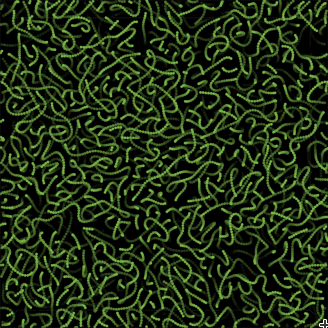Copyright 2012 neutronsources.org | All rights reserved. | Powered by FRM II | Imprint / Privacy Policy
Neutrons on the quest to find the fifth dimension in star polymer dynamics
Date: 07/11/2018
Source: ill.eu
From a humble plastic bag to ultra-light airplane wings – polymers are everywhere. These molecules are long chains of atoms that are chemically joined to play many roles that we all love (organic solar cells) and hate (indestructible plastic pollution). Polymers are useful in liquid form as well: the difference between tomato puree and ketchup is merely 0.5% of xanthan gum, which is a polymer made from sugar (see here). Ketchup is thick but not sticky, all thanks to the xanthan chains that are so long that they interpenetrate and form an entangled web which resists flow. The same principle also enables high tech applications like ink jet printing.
To decrease the amount of thickening additives, without compromising their effect on flow, we turn to branched polymers, rather than linear ones. The goal is to save costs and minimise the environmental impact of polymer-based products. To explain how it works, start with the concept of a random walk. Imagine you are on a hike and you play a game: toss a coin four times and take a step left for every ‘head’, and a step right for every ‘tail’. You will most often end up two steps away from the starting point. In fact, if we multiply the final distance by itself (2 × 2 = 4), it is equal to the number of random steps. This is the law of diffusion, and it governs the motion of small molecules like water.
For polymers, we have to take the random walk to higher dimensions. Imagine you are on a hike again, but this time you bring a hundred friends and for safety you all link up with a rope. Every member starts playing the random walk game, but the rope has some slack, so it takes a while for you to feel the pull of the entire team. This kind of motion is a random walk, embedded in another, slower random walk. Here you need to take 4 × 4 = 16 random steps to move a distance of two steps. Next, imagine hundreds of rope teams all mingled up so densely that you only have room to move up or down the line of your own team. The effect of the crowd brings us to 16 × 16 = 256 steps. Can you guess how many steps would you need if we add an extra branch to the middle of each rope team? Hint: it is not 256 × 256 = 65536. It takes a staggering 65536 × 65536 = 4.3 billion random attempts to get merely two steps away.
This result has been shown in a recent study, “5D Entanglement in Star Polymer Dynamics”, authored by Dr. Airidas Korolkovas, a long-term visitor at the Institut Laue-Langevin (ILL, France). Published in Advanced Theory and Simulations, a new journal focusing on breakthroughs in the science of modelling, it pioneers a unique computer algorithm to capture the billions of steps needed for entangled polymers. It runs on a Graphical Processing Unit (GPU, a massively parallel computing device) and takes advantage of texture mapping, an often overlooked functionality. Originally, this feature was designed for video games, but here it has been repurposed to calculate the molecular forces inside a little polymer droplet. Using a streamlined physics model, this simulation runs hundreds of times faster than traditional code. It opens new horizons on the time scales that can be addressed in scientific computing. This can further push the frontiers for a new generation of supercomputers, like the recently opened Summit at the Oak Ridge National Laboratory (ORNL), USA.
The effect of higher dimensional entanglement can be observed in experiments, using a technique called neutron spin-echo (NSE). It records the echo of the neutrons’ nuclear spin, as they scatter, or bounce off the polymer sample. A prime example is the IN15 beamline at the ILL, where the entanglement of linear polymers was first discovered. For star polymers, the simulation predicts a very specific NSE signal: entanglement in exactly 5 dimensions. Previously held theories were based on a vastly different assumption, called arm retraction, but so far it has never been proven at the molecular level. Thanks to constant upgrades at the ILL and elsewhere, an experimental verdict on this fundamental controversy may soon be within reach.
A combination of high performance computing and neutron scattering is a powerful tool of discovery for new materials that improve our quality of life and respect the environment.
Instrument: The spin-echo spectrometer IN15
Author contact: Airidas Korolkovas, Postdoctoral Researcher, Uppsala University and Large Scale Structures (LSS) group, Institut Laue-Langevin
Instrument contacts:Ingo Hoffmann / Peter Falus, IN15 Instrument Scientists, Institut Laue-Langevin
